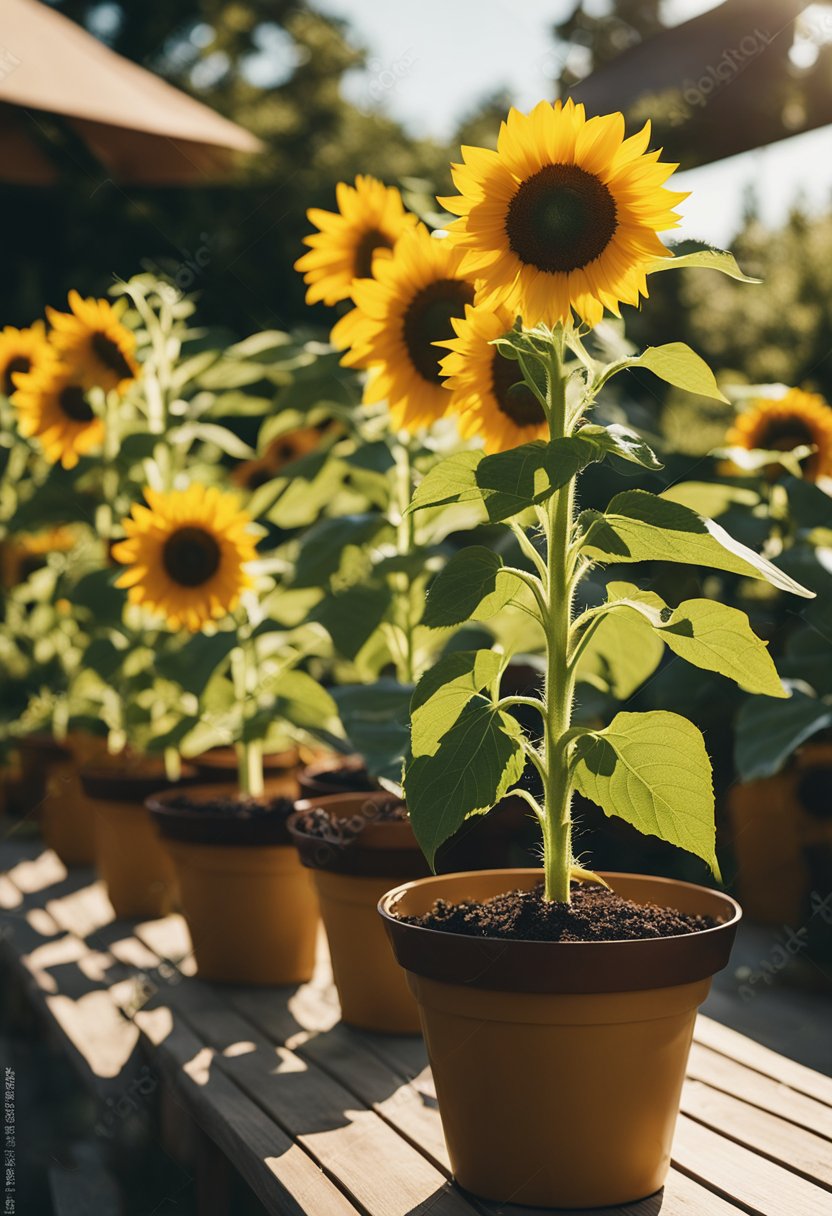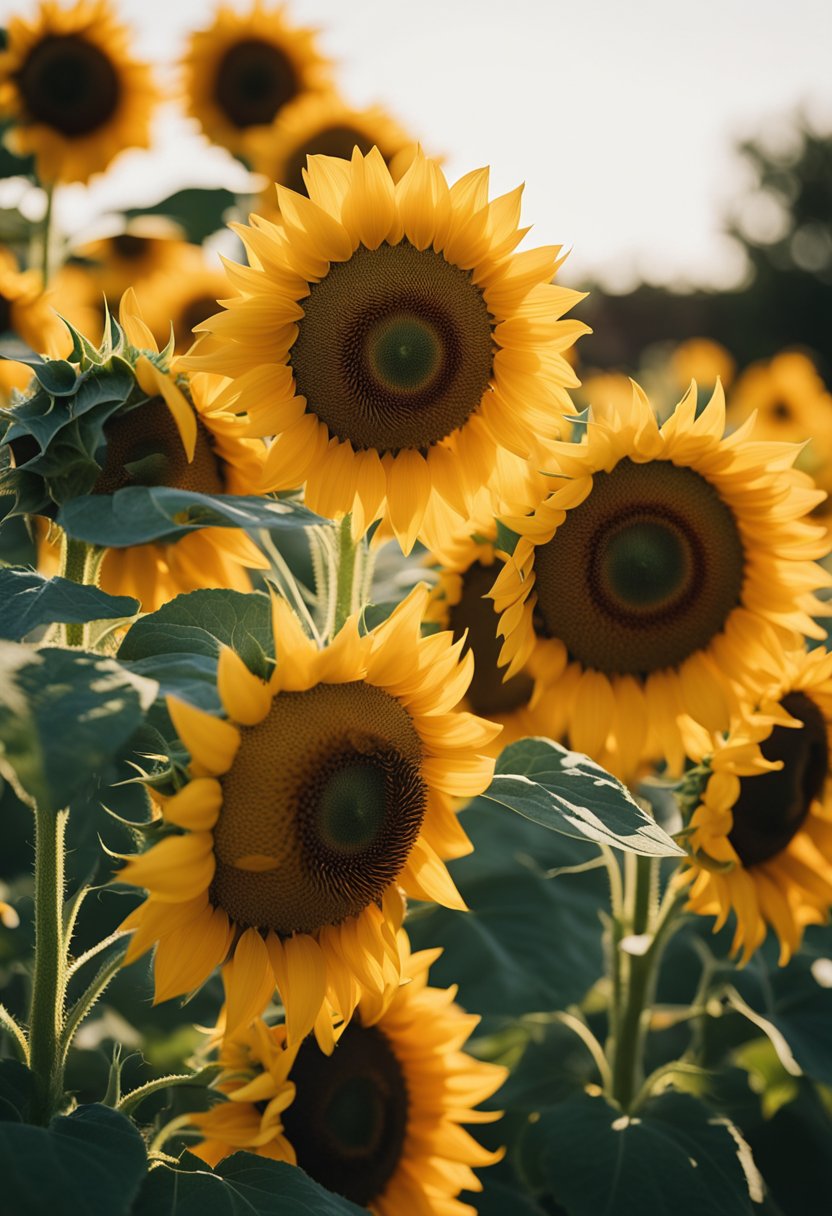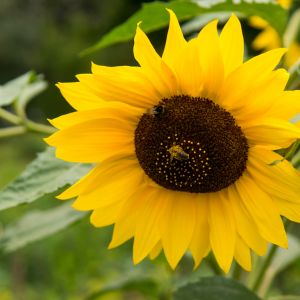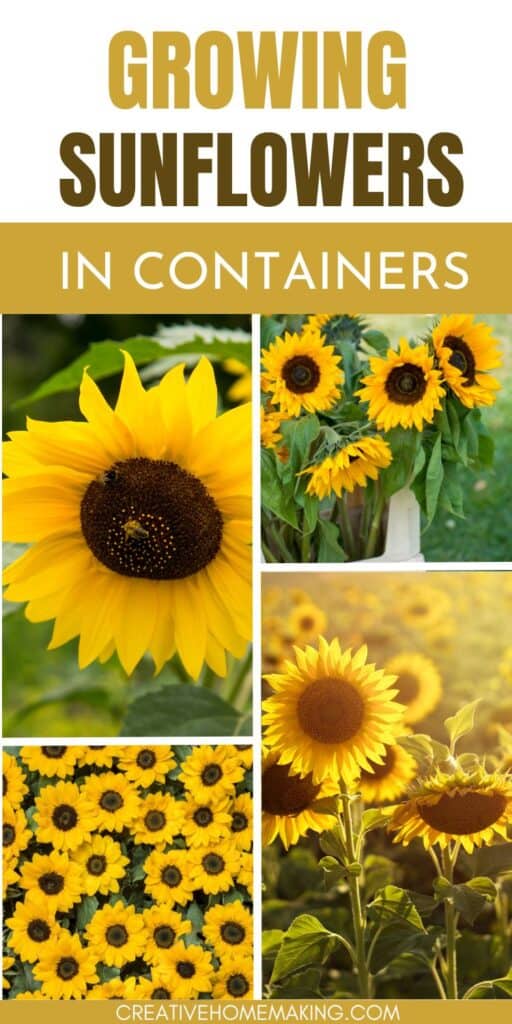If you’re looking to add a pop of color to your patio or balcony, growing sunflowers in containers is a great option.
This post may contain affiliate links.
Sunflowers are known for their bright yellow petals and large, round heads that can grow up to a foot in diameter. With the right care and attention, you can enjoy these beautiful flowers all summer long.
One of the benefits of growing sunflowers in containers is that they can be easily moved around to find the best spot for sunlight and temperature.
Plus, containers can help control the size of the plant, making them a great option for small spaces or those with limited planting areas. Whether you’re a seasoned gardener or just starting out, growing sunflowers in containers is a fun and rewarding experience.
To get started, you’ll need to choose the right container, soil, and sunflower variety. With a little bit of planning and preparation, you can create a beautiful container garden that will brighten up your outdoor space.
In this article, we’ll cover everything you need to know about growing sunflowers in containers, from selecting the right container to caring for your plants throughout the growing season.
Choosing the Right Containers

When it comes to growing sunflowers in containers, choosing the right container is key. The right container will provide your sunflowers with the necessary space and conditions to thrive. Here are some things to consider when choosing the right containers for your sunflowers.
Pot Size and Material
The size of your container is important when it comes to growing sunflowers. Sunflowers have deep roots, so it’s important to choose a container that is deep enough to accommodate them. A container that is at least 12 inches deep is recommended.
The material of your container is also important. Plastic pots are lightweight and easy to move around, but they can heat up quickly in the sun. A lightweight planter made of a breathable material like terracotta or clay can help keep the soil cool and prevent your sunflowers from overheating.
Related Article: When to Pinch Zinnias: A Quick Guide
Drainage Essentials
Good drainage is essential for growing sunflowers in containers. Without proper drainage, your sunflowers can become waterlogged and develop root rot. Make sure your container has drainage holes in the bottom to allow excess water to drain out.
To ensure good drainage, consider adding a layer of gravel or stones to the bottom of your container before adding soil. This will help create space for water to drain out and prevent soil from becoming compacted.
Selecting Sunflower Varieties
When it comes to selecting sunflower varieties for container gardening, there are a few things to keep in mind. You want to choose a variety that will thrive in a container, and that will fit your space and design preferences. Here are some things to consider:
Related Article: When to Plant Flowers for Spring: A Helpful Guide
Dwarf vs. Giant Sunflowers
One of the first decisions you’ll need to make is whether you want to grow dwarf or giant sunflowers. Dwarf sunflowers are perfect for container gardening because they don’t get too tall, and they have a compact, bushy growth habit. Some popular dwarf varieties include the Teddy Bear and Sungold Dwarf.
Giant sunflowers, on the other hand, can grow up to 12 feet tall or more, and they have a branching type of growth. If you have a large container or want to make a statement with your sunflowers, a giant variety like the Mongolian Giant or Mammoth Sunflowers might be the way to go.
Biggest Sunflower in The World | 10 Seeds to Grow | Mongolian Sunflower Seeds, Huge 18 Inch Flowers
Sunflower Cultivars
In addition to size, there are many different types of sunflowers to choose from, each with its own unique characteristics. Here are a few popular cultivars to consider:
- Russian Sunflowers: These sunflowers have a dark center disk and bright yellow petals. They are easy to grow and can reach up to 10 feet tall.
- Perennial Sunflowers: If you want sunflowers that will come back year after year, consider planting a perennial variety. These sunflowers have smaller blooms than annual varieties, but they are still beautiful and easy to care for.
- Branching Varieties: Some sunflowers have a branching growth habit, which means they produce multiple blooms on one plant. These varieties are great for adding a lot of color and interest to a container garden.
No matter what type of sunflower you choose, make sure to select a variety that is suitable for container gardening. With the right care and attention, your sunflowers will thrive and bring beauty to your space.
Related Article: Growing Huge Pumpkins: Tips and Tricks for a Bountiful Harvest

Planting and Soil Preparation
Soil Composition
When growing sunflowers in containers, it’s important to select the right soil composition. A good potting mix should have a balance of nutrients, moisture retention, and drainage.
Related Article: Are Tea Bags Good for Plants? A Guide to Using Tea Bags for Gardening
You can make your own potting mix by combining equal parts of compost, peat moss, and perlite. Alternatively, you can purchase a pre-made potting soil from your local garden center.
Sowing Seeds and Transplanting Seedlings
Once you have your soil ready, it’s time to sow your sunflower seeds or transplant your seedlings. If you are sowing seeds, make sure to plant them about one inch deep and three inches apart.
Cover the seeds with soil and water gently. If you are transplanting seedlings, make sure to gently remove them from their original container and place them in a slightly larger container with fresh potting soil.
Related Article: How to Transplant Hollyhocks
When planting or transplanting your sunflowers, make sure to choose a container that is at least 12 inches deep and 12 inches wide. This will give your sunflowers enough room to grow and develop a strong root system.
Additionally, make sure to place your container in a sunny location, as sunflowers require at least six hours of direct sunlight per day.
Caring for Potted Sunflowers
Growing sunflowers in containers can be a fun and rewarding experience. However, it is important to take proper care of your potted sunflowers to ensure they thrive. Here are some tips to help you care for your potted sunflowers.
Watering and Feeding
Sunflowers require regular watering to thrive. Make sure to water your potted sunflowers deeply and regularly, especially during hot and dry weather. It is important to ensure that the soil is well-draining to prevent waterlogging, which can lead to root rot.
In addition to proper watering, sunflowers also require regular feeding. Fertilize your potted sunflowers with a slow-release fertilizer that is high in nitrogen. You can also use a liquid plant food to feed your sunflowers every two weeks during the growing season.
Sunlight and Positioning
Sunflowers require full sun to grow and thrive. Make sure to position your potted sunflowers in a spot that receives direct sunlight for at least six hours a day. If you do not have a suitable spot with enough sunlight, you can use a grow light to supplement natural light.
It is also important to position your potted sunflowers in a location that is protected from strong winds and extreme weather conditions. This will help prevent damage to the plants and ensure they continue to grow strong and healthy.
Supporting and Protecting Your Sunflowers
As your potted sunflowers grow, they may require additional support to prevent them from toppling over. You can use stakes or other supports to help keep your sunflowers upright. It is also important to deadhead your sunflowers regularly to encourage new growth and prevent disease.
Finally, it is important to protect your potted sunflowers from pests and other threats. You can use mulch and other protective measures to help prevent damage from insects and other pests. With proper care, your potted sunflowers will grow strong and healthy, providing you with beautiful blooms all season long.
Dealing with Pests and Diseases
Common Pests
When growing sunflowers in containers, you may encounter pests such as aphids, slugs, and snails. These pests can quickly damage your plants, so it’s important to take action as soon as you notice them. Here are some tips on how to deal with common pests:
- Aphids: These tiny insects can be found on the undersides of leaves and can cause stunted growth and yellowing of leaves. To get rid of them, you can spray your plants with a mixture of water and dish soap or use a natural insecticide.
- Slugs and snails: These slimy creatures can munch on your sunflower leaves and flowers. You can prevent them from reaching your plants by placing copper tape around the container or using a natural slug repellent like coffee grounds or eggshells.
- Beetles: Beetles can chew holes in the leaves of your sunflowers. You can handpick them off your plants or use a natural insecticide.
Disease Prevention
Sunflowers are susceptible to diseases such as powdery mildew and stem rot. To prevent these diseases from affecting your plants, here are some tips:
- Provide good air circulation: Make sure your plants are not overcrowded and have enough space to grow. This will help prevent the spread of diseases.
- Water your plants properly: Overwatering can lead to root rot, while underwatering can cause stress to your plants. Make sure your soil is well-draining and water your plants when the top inch of soil is dry.
- Keep your plants clean: Remove any dead or diseased leaves from your plants and clean your containers regularly to prevent the buildup of fungi and bacteria.
By following these tips, you can prevent pests and diseases from damaging your sunflowers and enjoy a healthy and vibrant container garden.
Frequently Asked Questions
How often should sunflowers in containers be watered?
Sunflowers in containers require more frequent watering than those grown in the ground. You should water them whenever the top inch of soil feels dry to the touch.
This may mean watering them once or twice a day, depending on the weather and the size of the container. Be sure not to overwater, as this can lead to root rot and other issues.
What are the best practices for growing sunflowers from seed in pots?
To grow sunflowers from seed in pots, start by filling your container with a good quality potting mix. Sow the seeds about 1 inch deep and 6 inches apart.
Water the soil well and keep it moist until the seeds germinate. Once the seedlings have emerged, thin them out so that each plant has enough space to grow. Be sure to provide plenty of light and water as needed.
Can giant sunflowers be successfully grown in containers, and if so, how?
Yes, giant sunflowers can be grown in containers, but they will require a very large container and extra support to keep them from falling over. Choose a container that is at least 24 inches deep and wide, and fill it with a good quality potting mix.
Plant the seeds about 1 inch deep and 12 inches apart. As the plants grow, provide support with stakes or a trellis, and be sure to water and fertilize regularly.
Is pruning necessary for sunflowers grown in pots, and what is the proper technique?
Pruning is not necessary for sunflowers grown in pots, but it can help to promote bushier growth and more flowers. To prune, simply pinch off the top of the stem when the plant is about 12 inches tall.
This will encourage the plant to branch out and produce more flowers. You can also remove any yellow or damaged leaves as needed.
What are the tips for transplanting sunflowers to ensure their health and growth in pots?
When transplanting sunflowers to a larger container, be sure to choose a container that is at least 2-3 inches larger than the current one. Fill the new container with potting mix and make a hole in the center.
Carefully remove the sunflower from its current container and place it in the new one, filling in around it with additional potting mix. Water the plant well and keep it out of direct sunlight for a few days to help it recover.
What is the ideal size and type of planter for growing healthy sunflowers in containers?
The ideal size and type of planter for growing sunflowers in containers will depend on the variety of sunflower you are growing. Generally, larger varieties will require larger containers, while smaller varieties can be grown in smaller containers.
A good rule of thumb is to choose a container that is at least 12 inches deep and wide for smaller varieties, and up to 24 inches deep and wide for larger varieties. Be sure to choose a container with drainage holes to prevent water from accumulating in the bottom.
Follow my gardening board on Pinterest.





